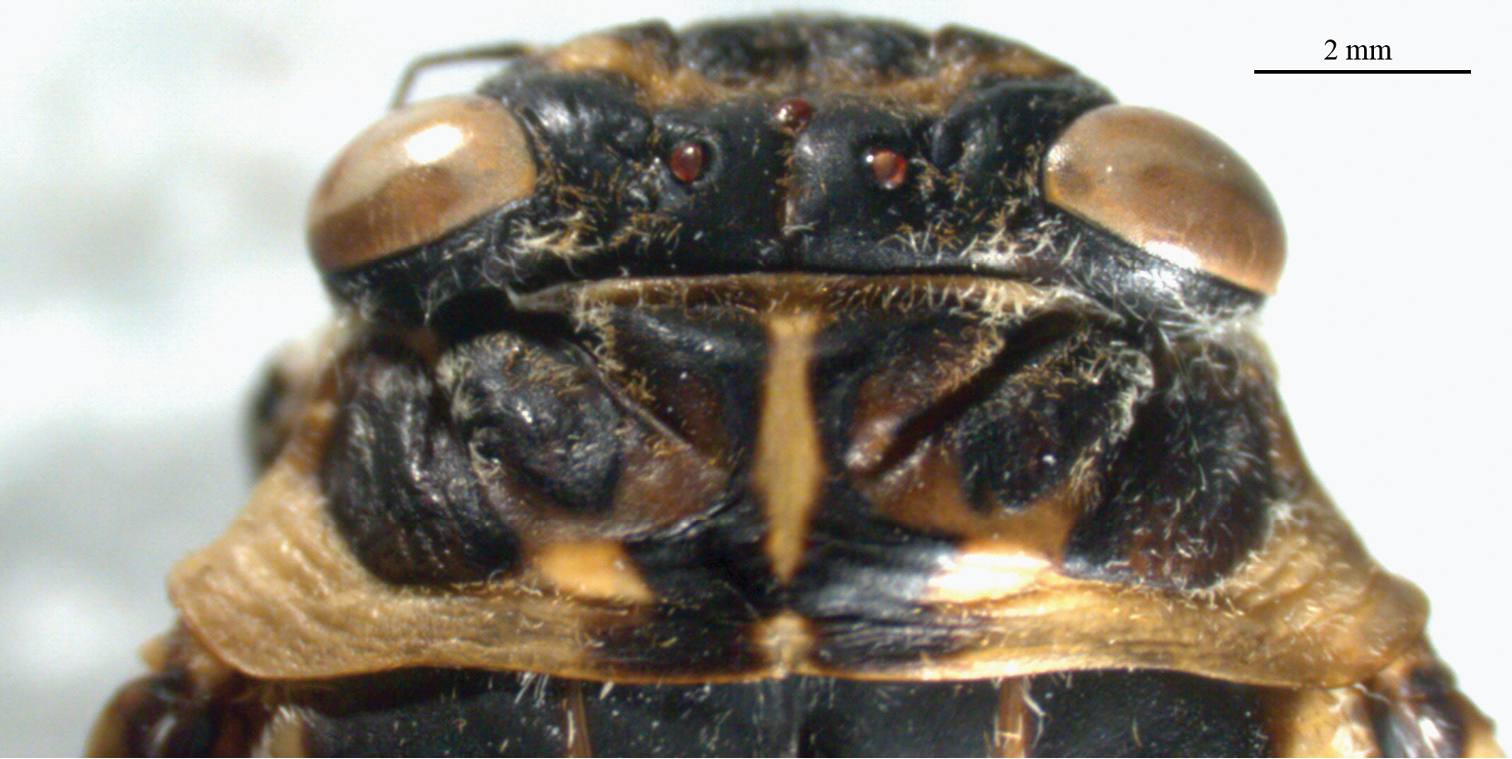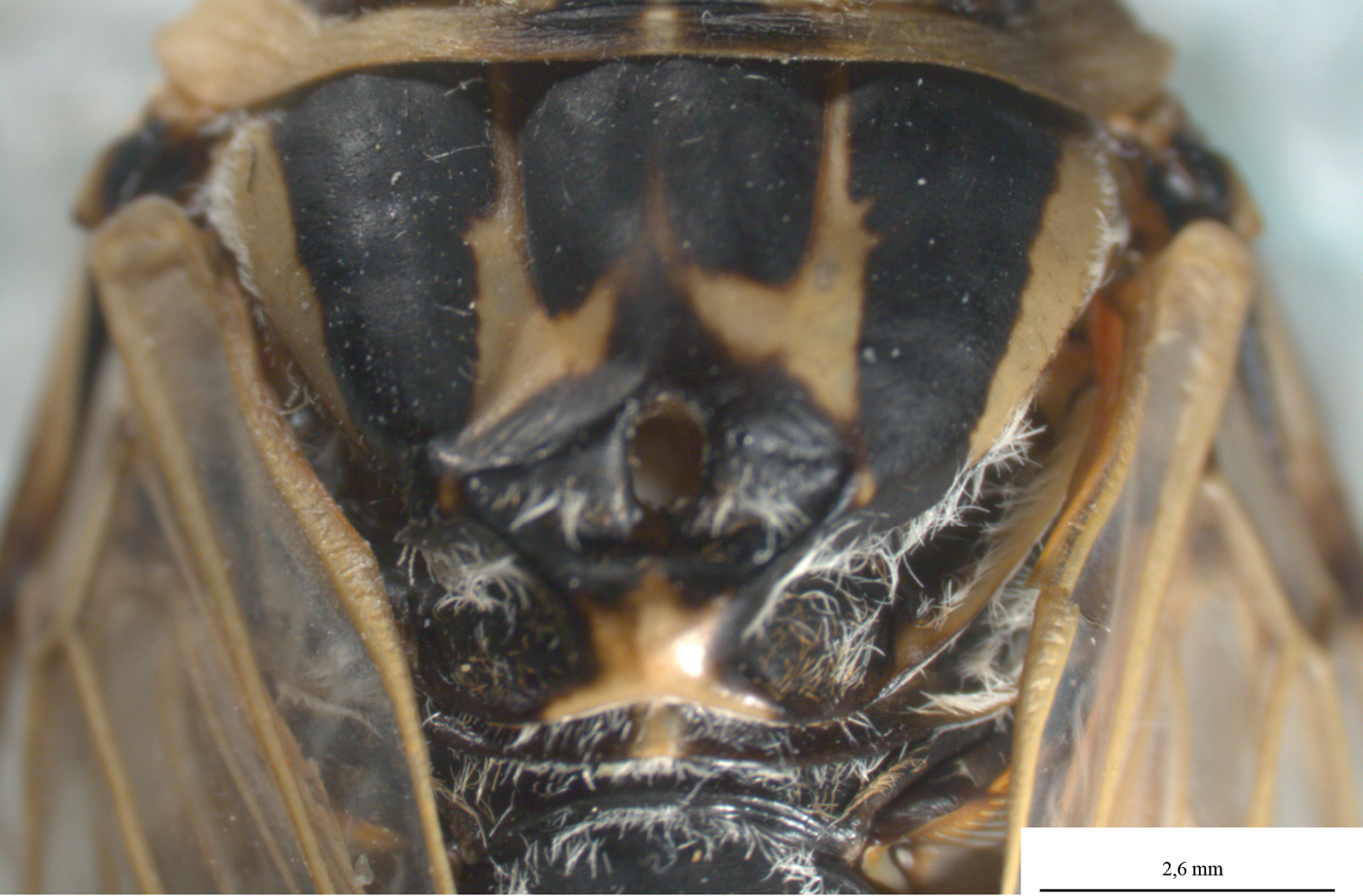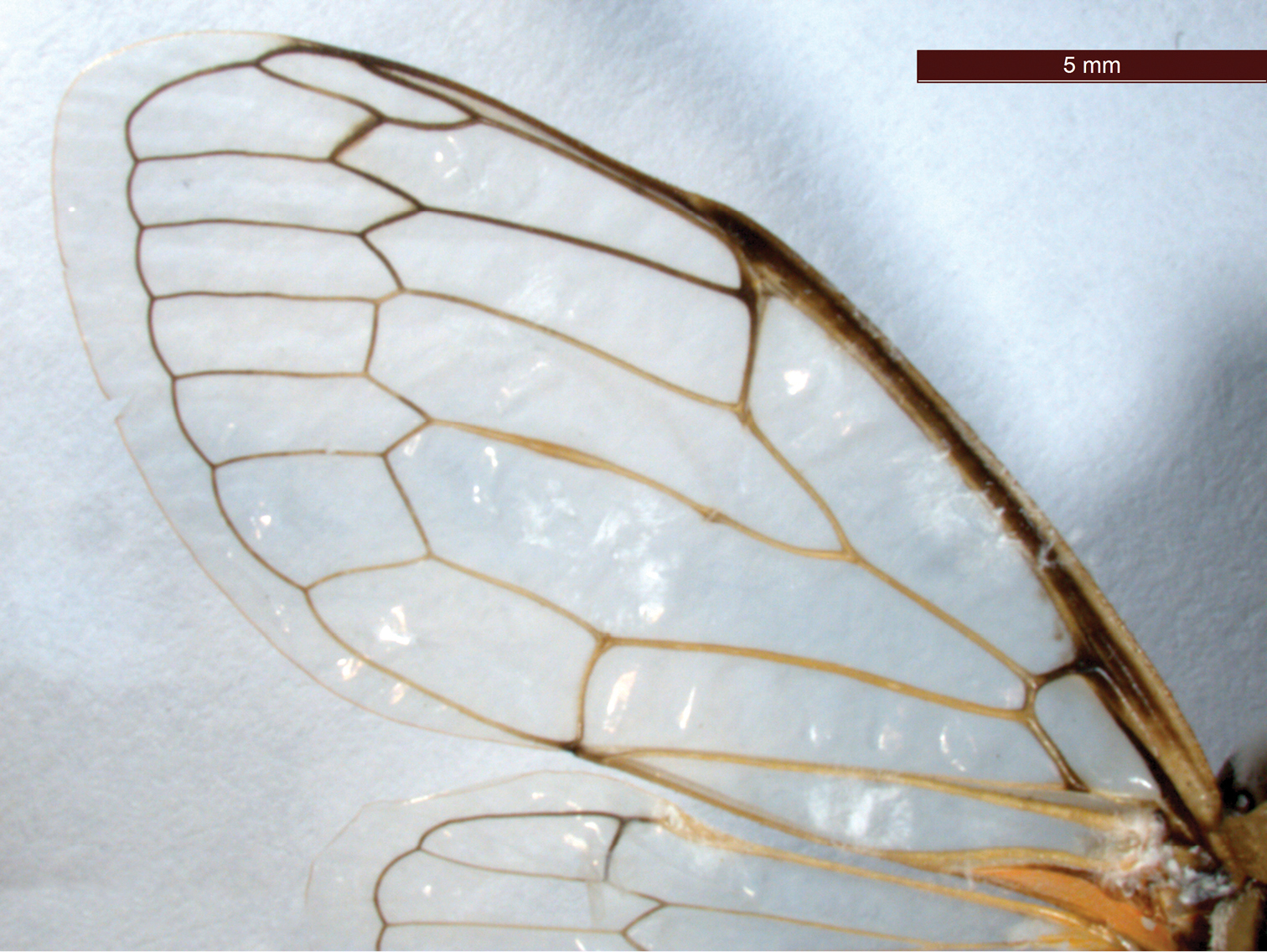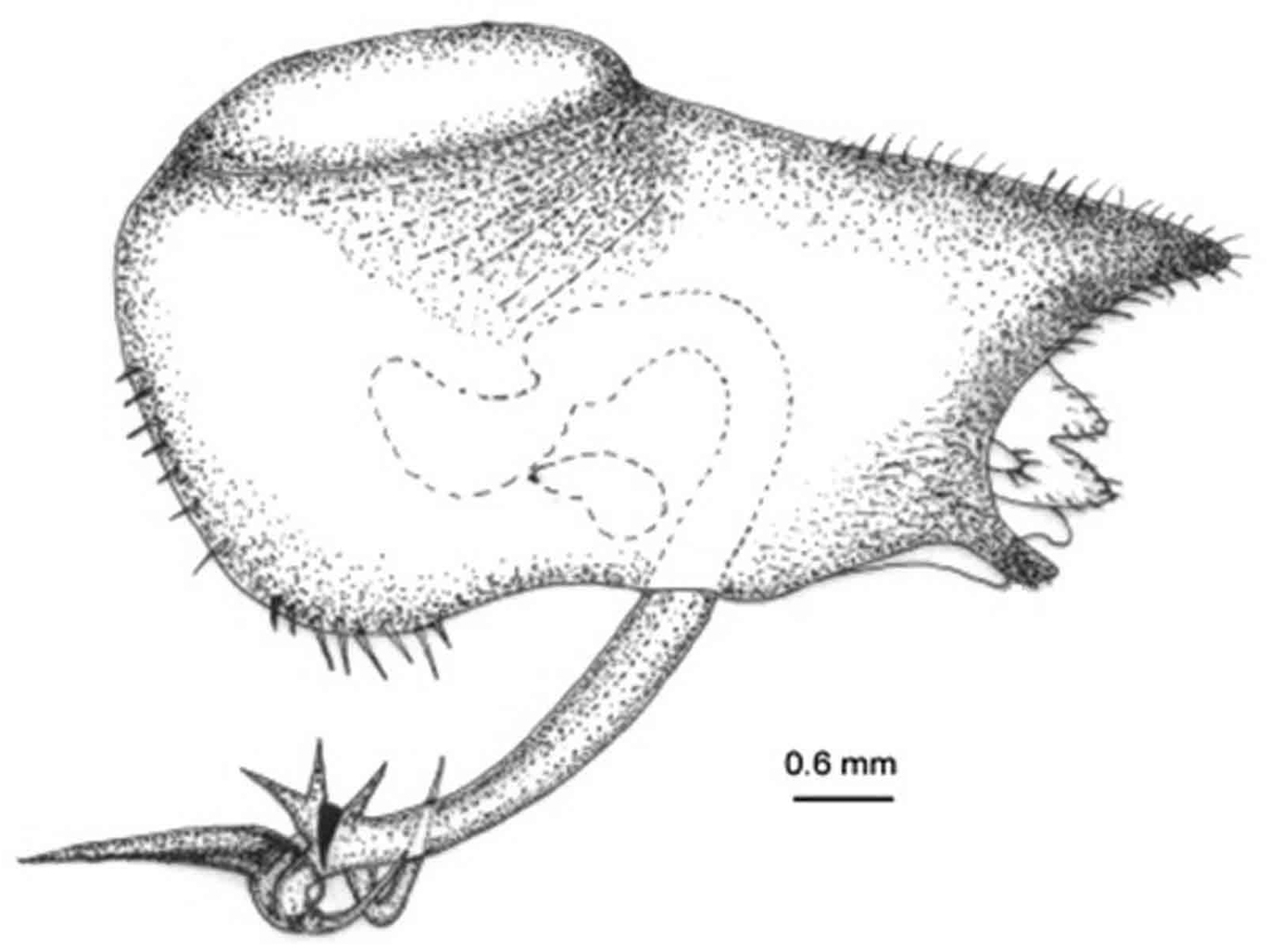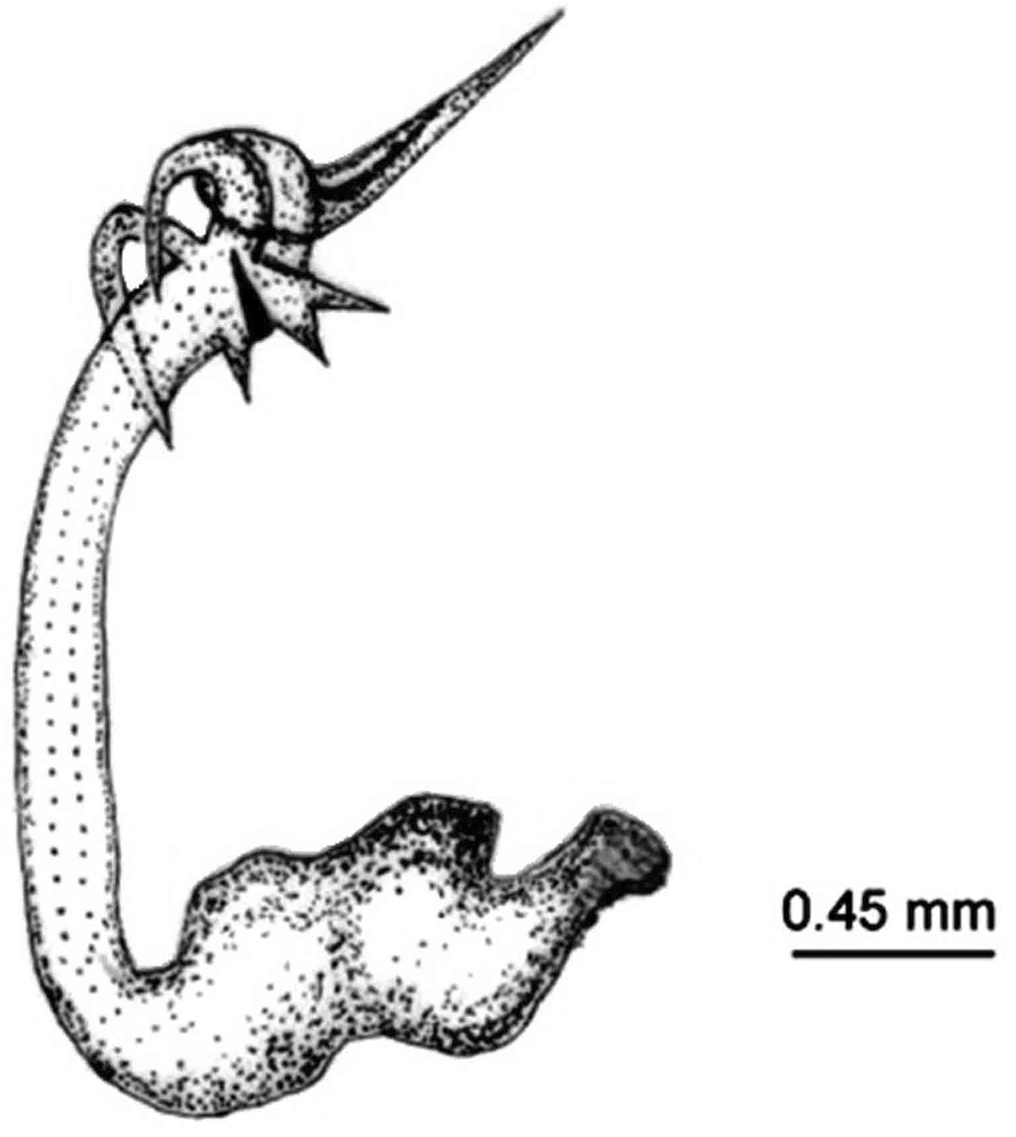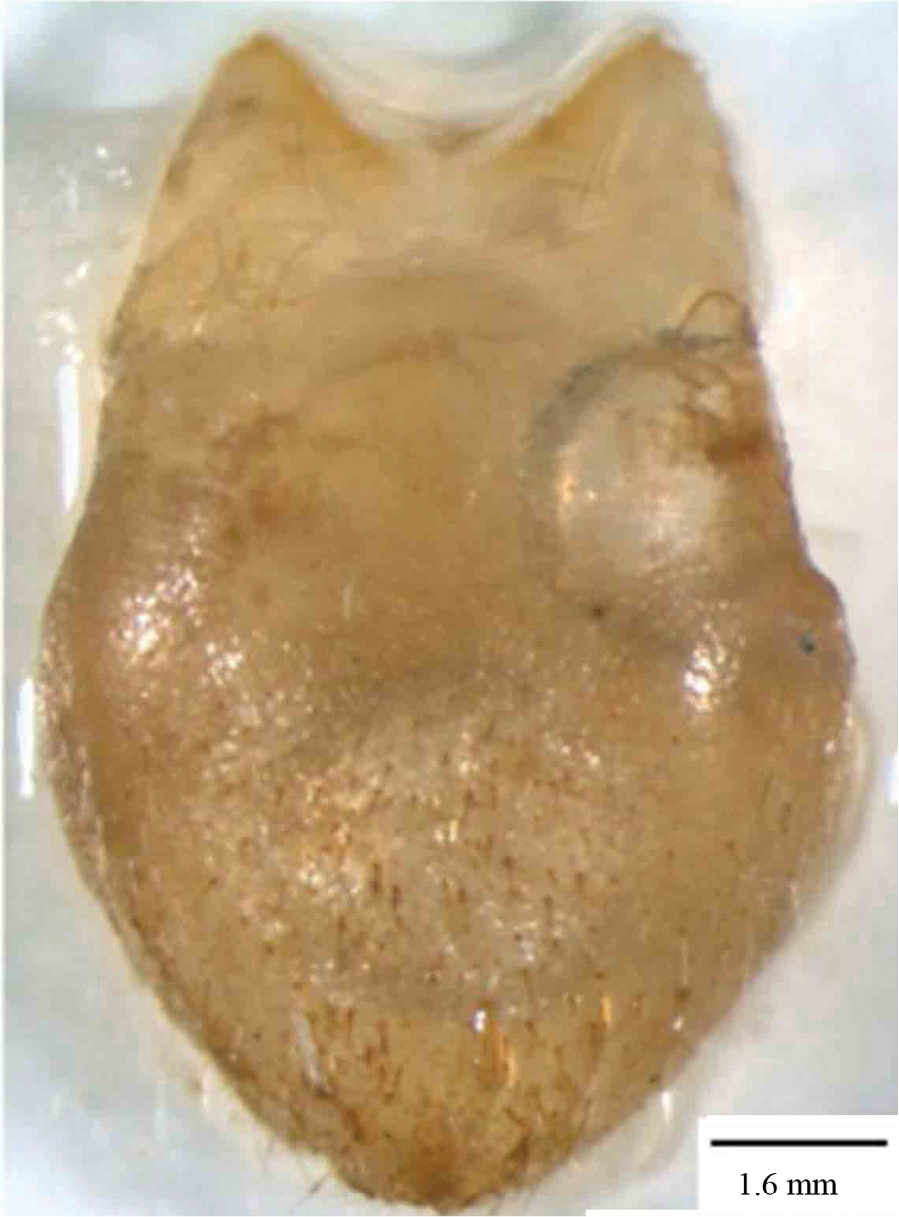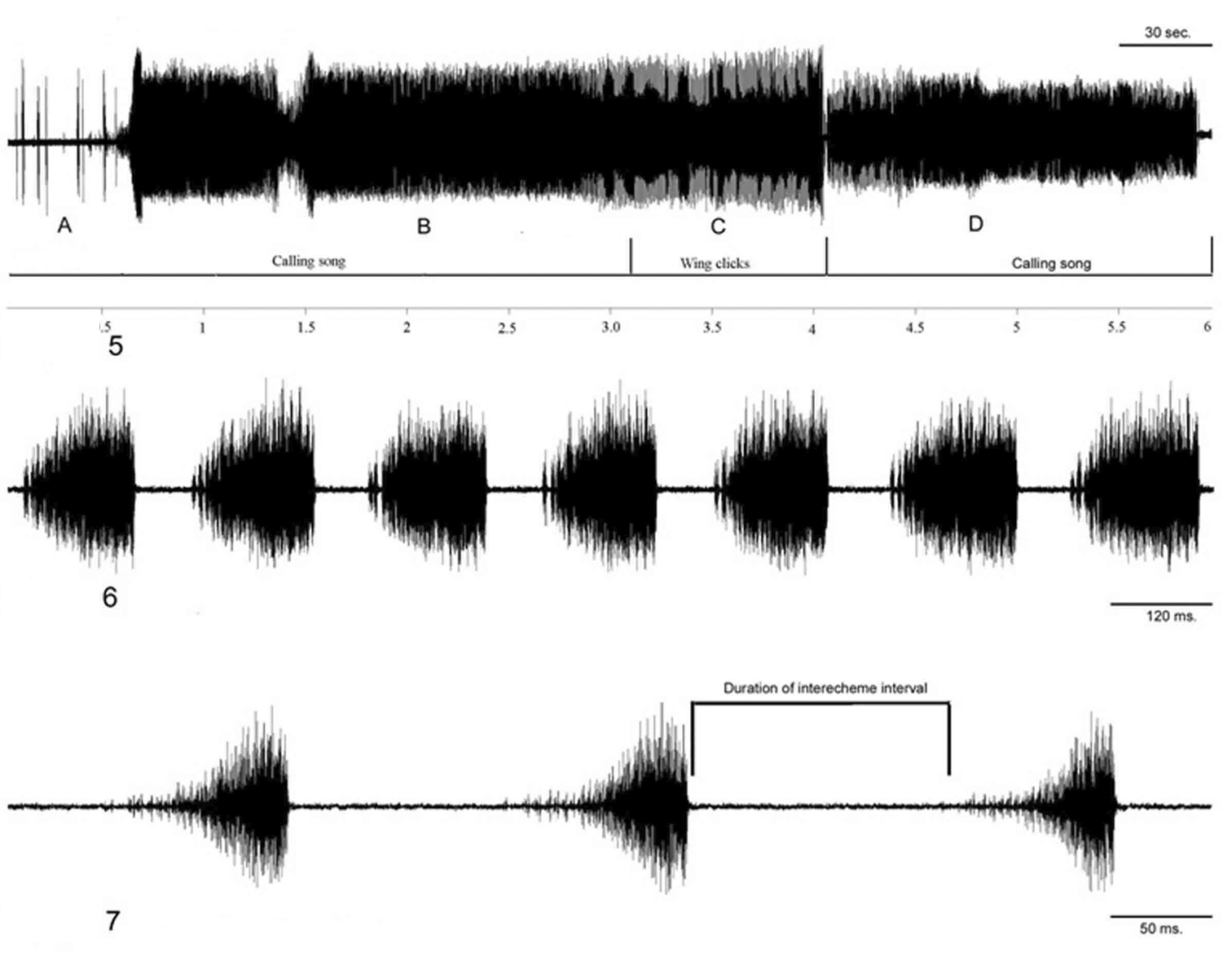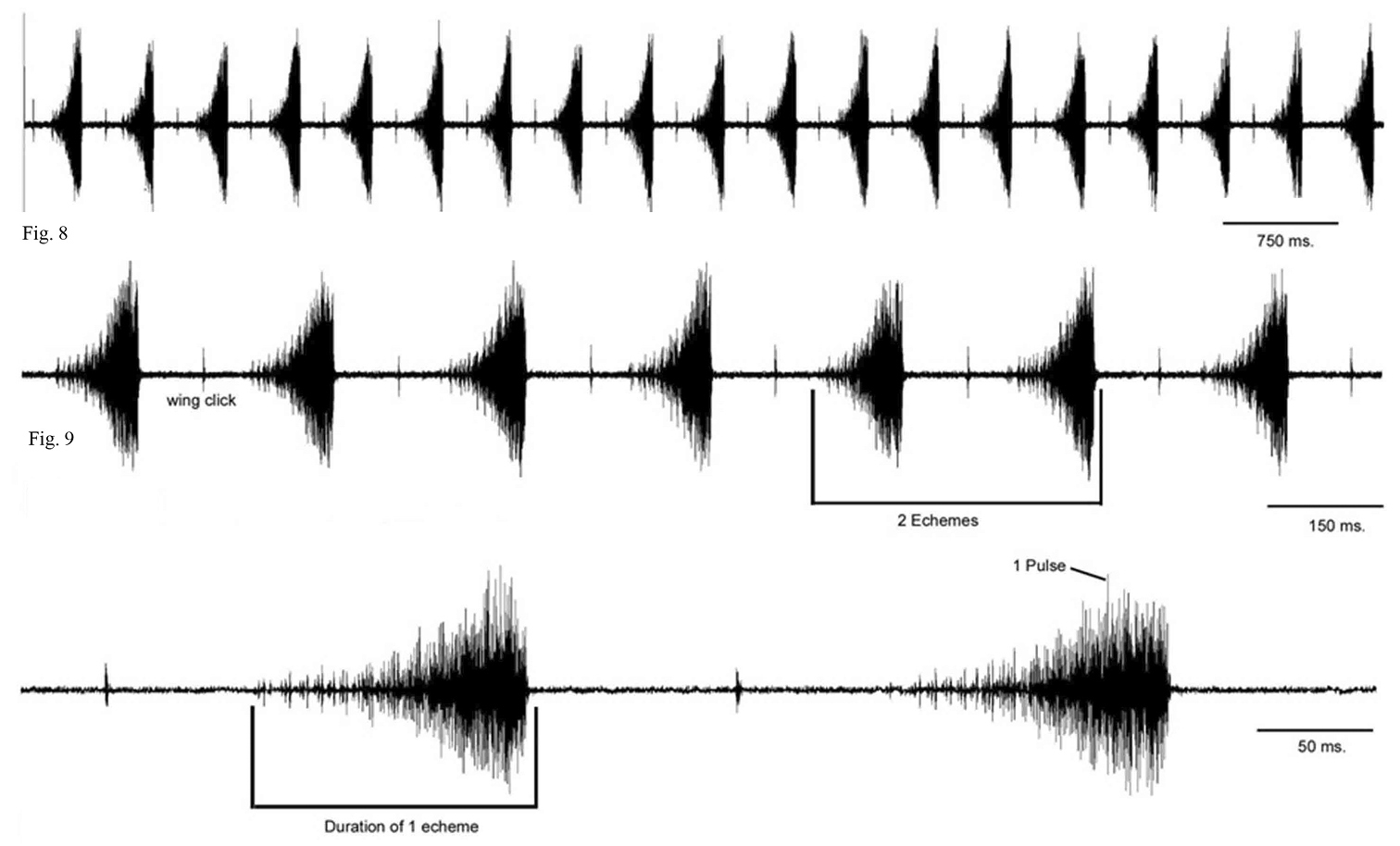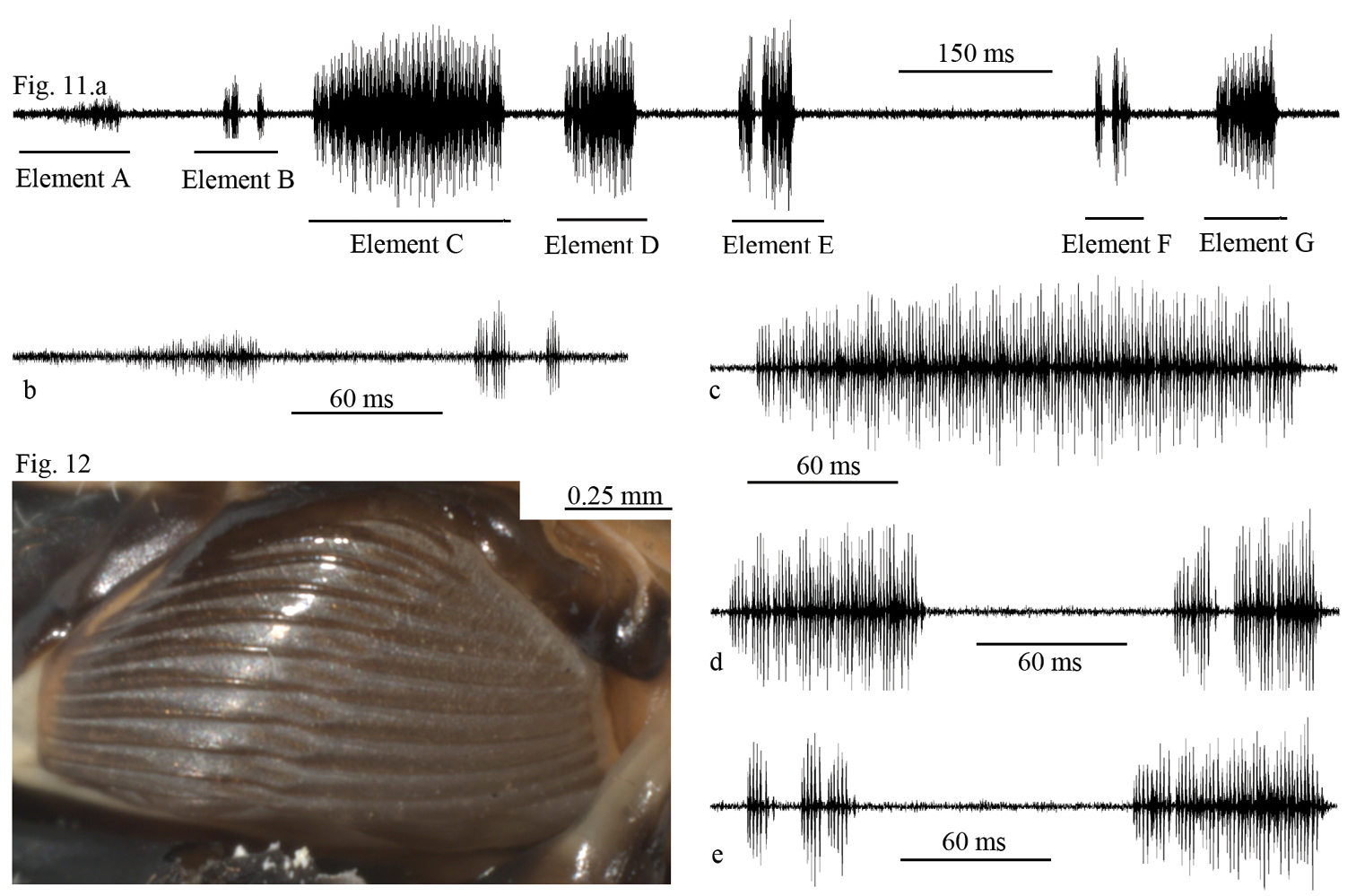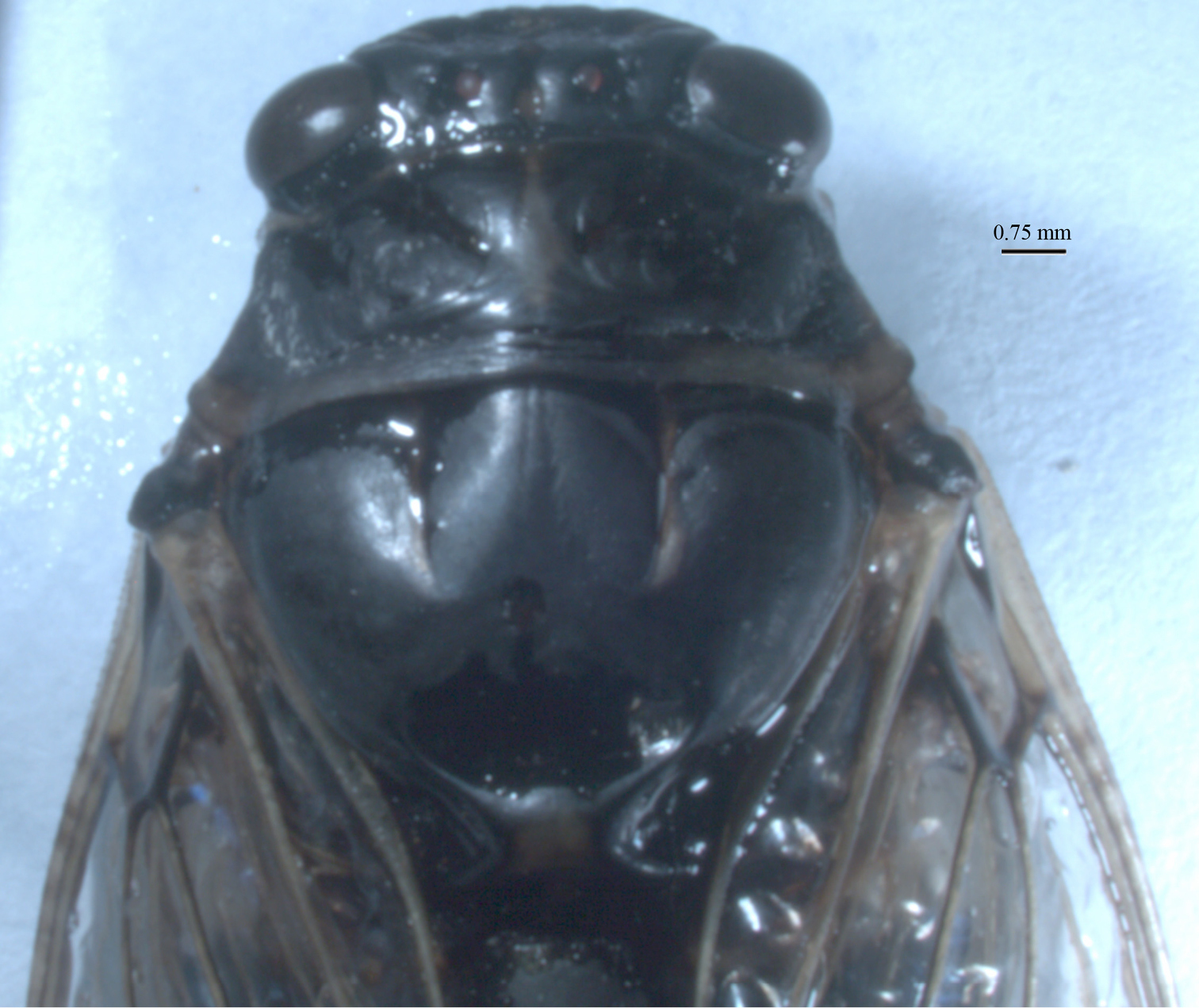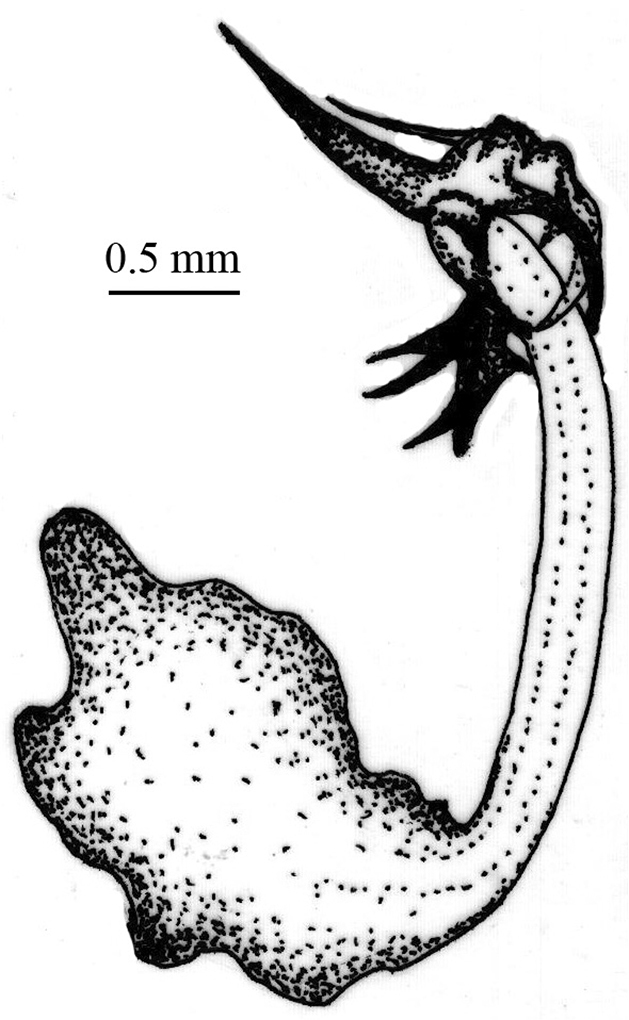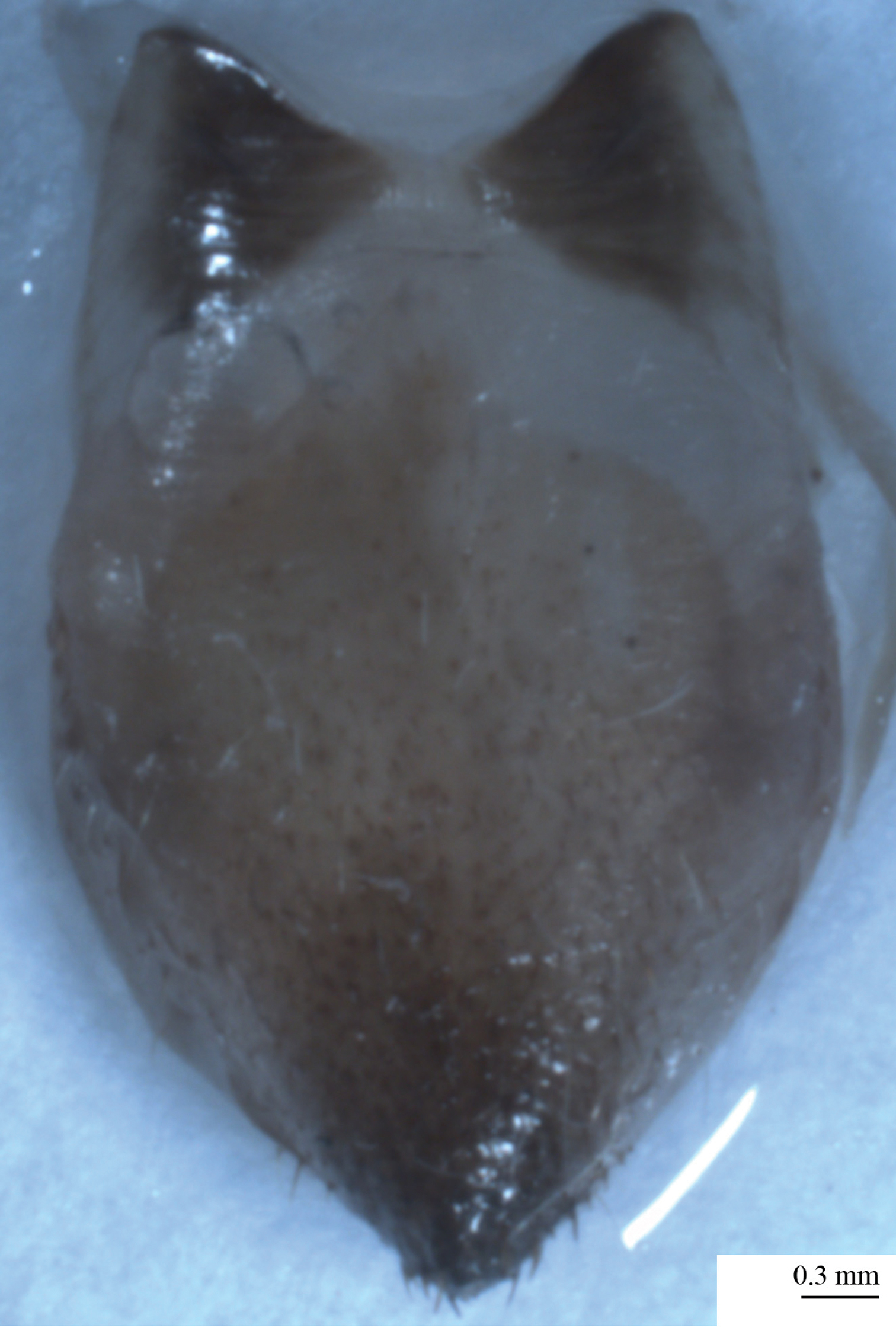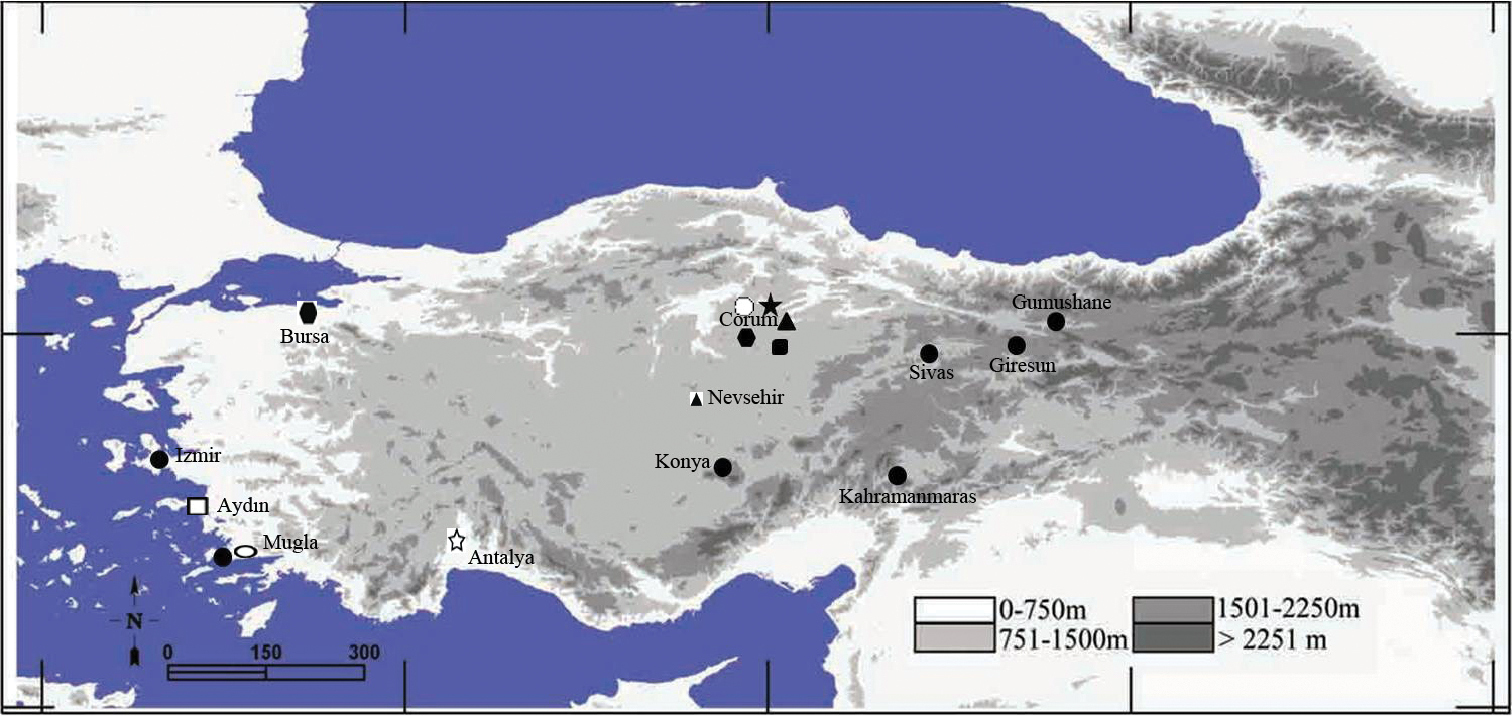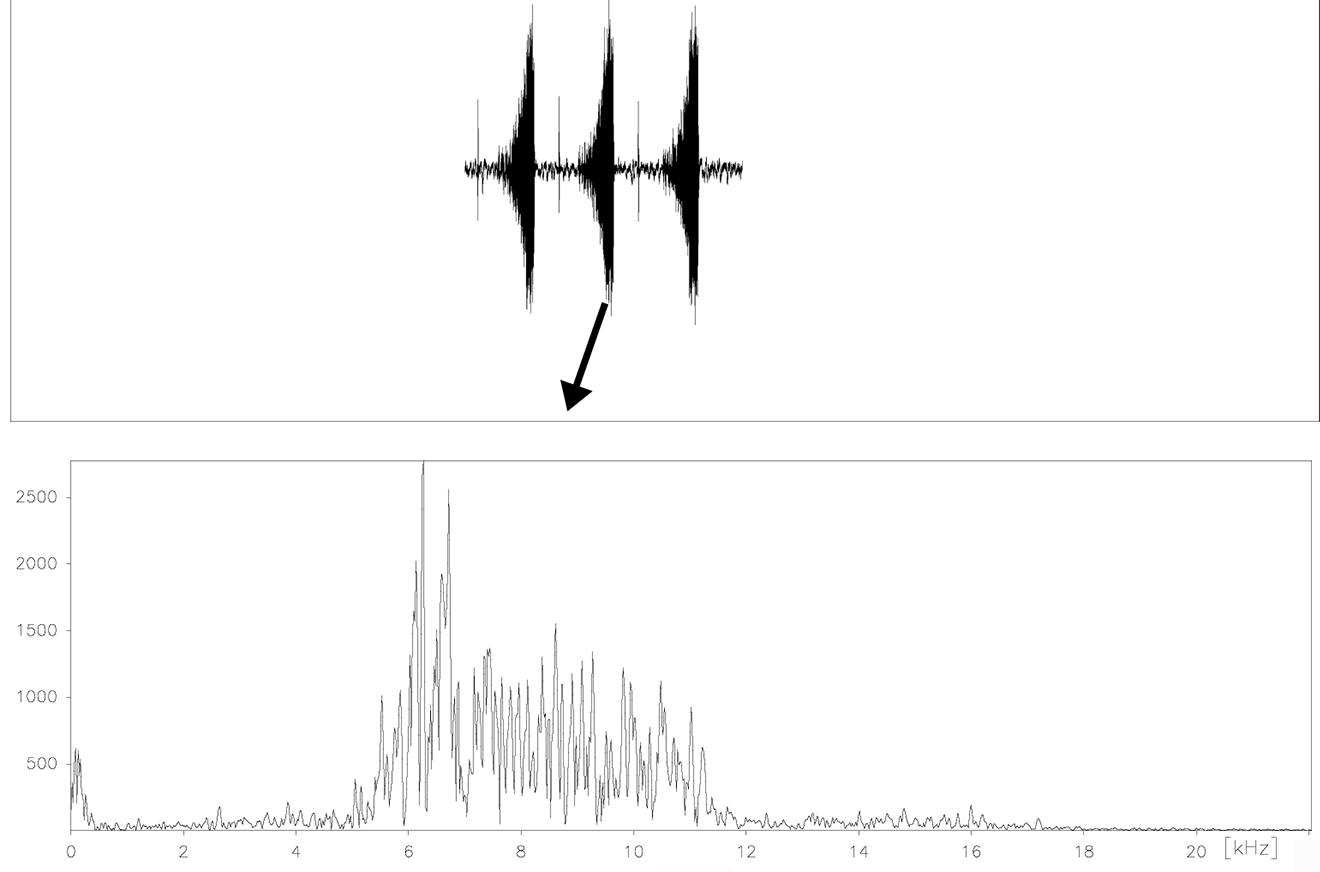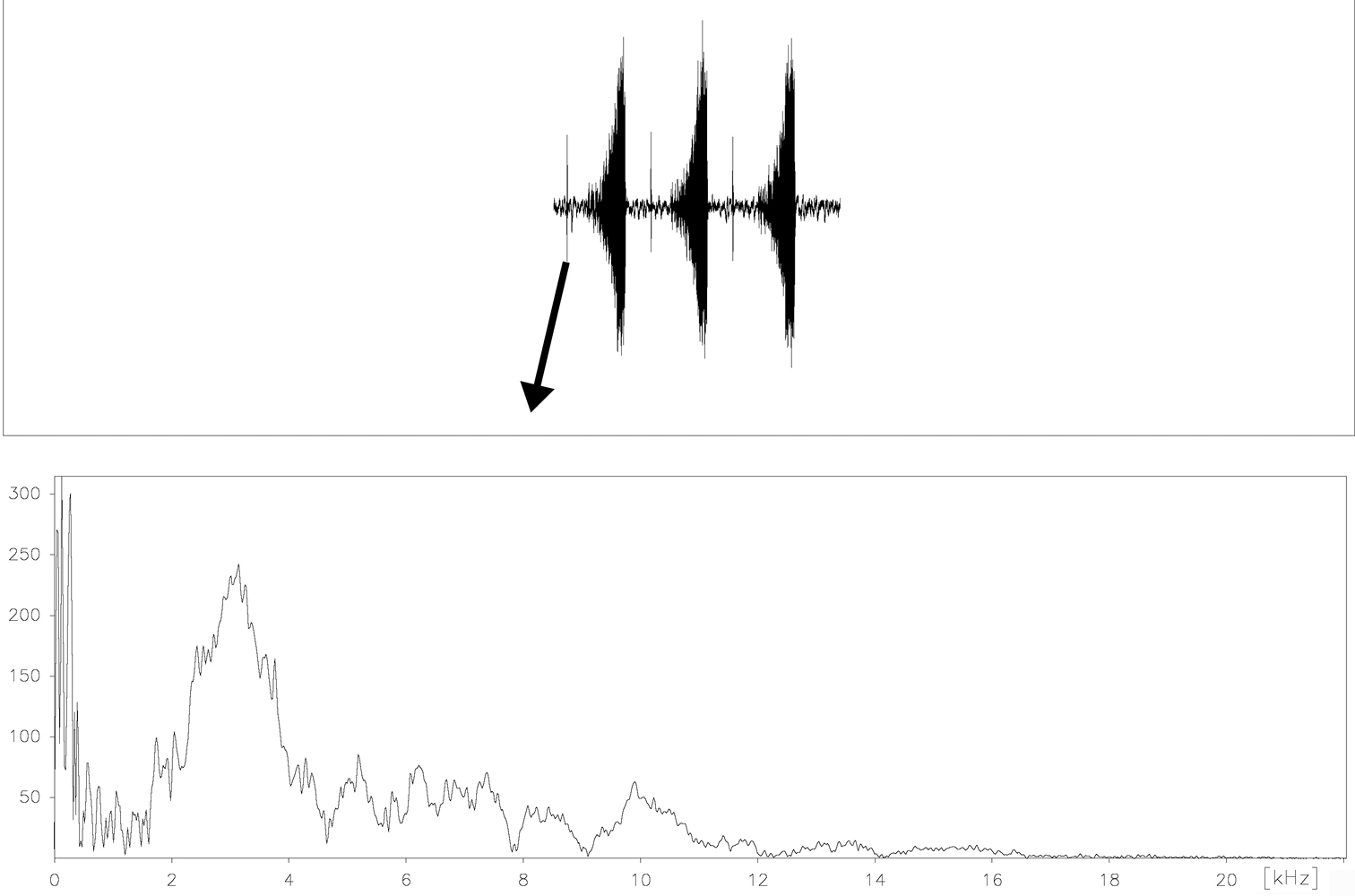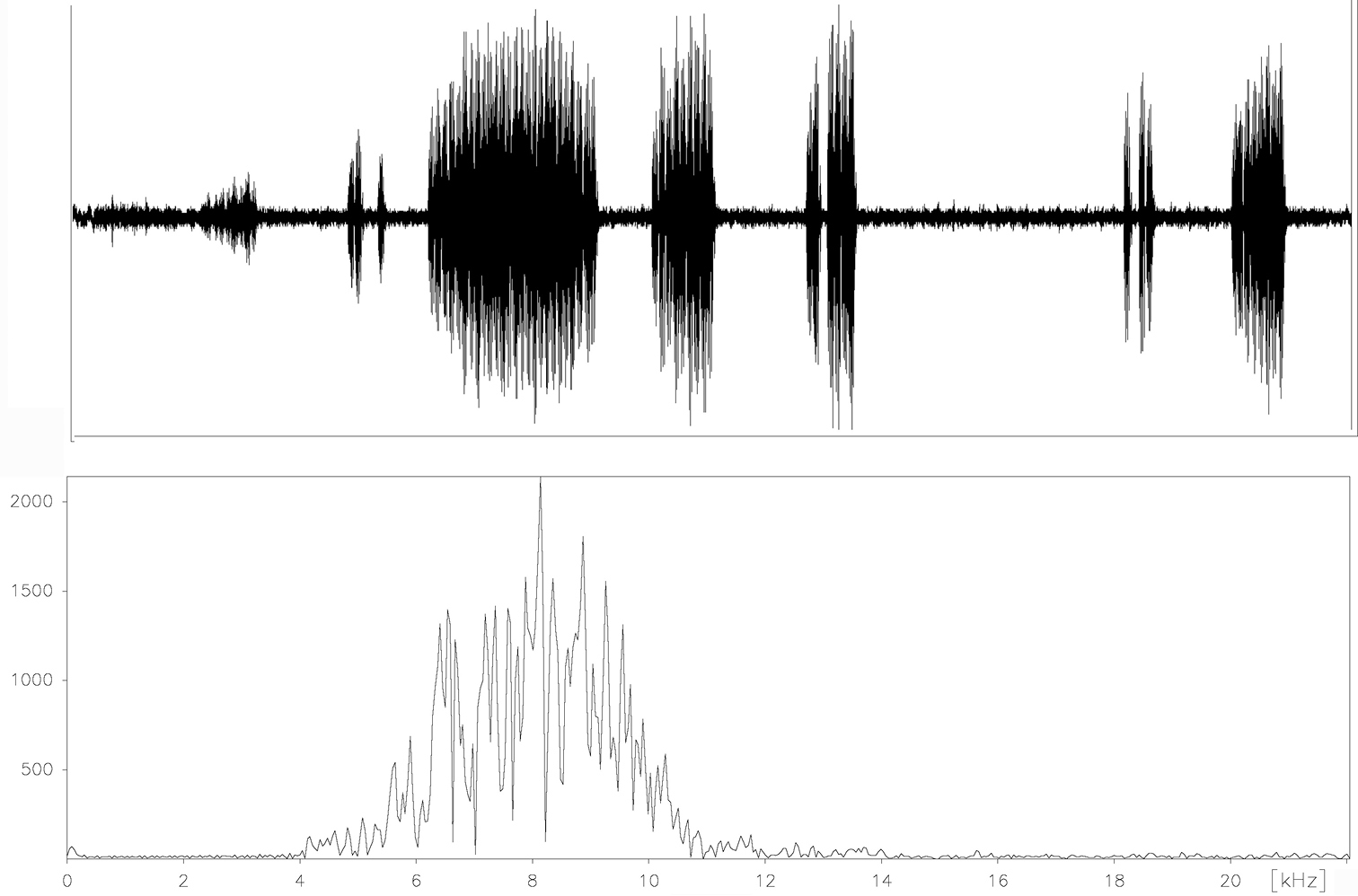






(C) 2013 Abbas Mol. This is an open access article distributed under the terms of the Creative Commons Attribution License 3.0 (CC-BY), which permits unrestricted use, distribution, and reproduction in any medium, provided the original author and source are credited.
For reference, use of the paginated PDF or printed version of this article is recommended.
Acoustic and morphological characters are very important to distinguish species of Cicadidae. In this study, the morphological and acoustic characters of Cicadatra platyptera Fieber, 1876 (Hemiptera, Cicadidae) collected from Turkey were analysed. The external morphological structures of two species were drawn and photographs of some specimens were taken. We evaluated taxonomically important morphological characters such as body shape, colors, patterns, structure, and genital structure. We evaluated measurements of external morphological structures and acoustics characters of Cicadatra platyptera from Turkey, partly with statistical analyses. Morphological characters were compared and differentiated from the closely related species, Cicadatra atra. The distribution in Turkey including previous records and the material examined were shown on a map, and the distribution in Palearctic Region was given.
Hemiptera, Cicadidae, Cicadatra platyptera, Cicadatra atra, morphology, acoustics, Turkey
It is known that there are more than 40 species of the genus Cicadatra Kolenati, 1857 many of which are distributed in Middle East countries and surrounding areas (
Acoustic signals in insects are widely used both for intra- and inter-specific communication. The loud airborne sounds of many groups of large cicadas are well known (
Different acoustic parameters of continuous song, calling song, courtship song, and alarm song are very important to determine relationships between some Auchenorrhyncha species (
Thus, in the present study, we aimed (i) to review Cicadatra platyptera Fieber, 1876 thoroughly using morphological characters; (ii) to describe calling songs with variations, courtship song and alarm song; (iii) to evaluate their relationship with the closely related species in terms of some morphological and acoustics characters.
The research materials were Cicadatra platyptera (Cicadidae) adult specimens collected from Turkey (Fig. 17). Firstly, the sounds of adult males living in natural habitat were recorded. Field recordings of the songs were done with a Sony Cassette-Recorder WM-GX 688 and with a Sony flat frequency response microphone (50 Hz to 18 kHz). Then, the specimens were collected with a sweep net and prepared as per standard methods. The important taxonomic characters of prepared specimens such as external morphological structures and genital structure were examined and were drawn or photographed with a digital camera or camera lucida attached to a stereo microscope. In order to compare parameters, SPSS (15.0) software package was used and T-test of independent-samples was applied. Differences of P< 0.05 were considered as significant. Male songs which were recorded with Sony Cassette-Recorder were transferred to computer with COOL EDIT 96 software and filtered to clear the sound, then were analysed with TURBOLAB 4.0.Oscillograms and frequency (digitalized at 44100 Hz) of the sound of male calling songs were prepared and analysed by using COOL EDIT 96, TURBOLAB 4.0 (STAMMER AG) and ADOBE PHOTOSHOP programs on computer.
To identify the specimens as Cicadatra platyptera Fieber, 1876, we used the morphology by
Type species. Cicadatra atra (Oliver, 1790)
http://species-id.net/wiki/Cicadatra_platyptera
Figs 1–12, 17–21, Table 1–4Redescription: Male. General appearance of body black with yellowish and white pile.
Head. General color of head blackish yellow with white scattered pile. Vertex blackish with sparse pile and some specimens have yellowish area between ocelli and top of postclypeus surrounded by yellowish area. Eyes yellowish brown and rarely blackish. Ocelli reddish brown and rarely yellowish. Epicranial suture generally yellowish. Antennae blackish. Frons black with white pile. Postclypeus with a central sulcus obvious transverse grooves with long pile specifically located near gena and edge of mandibular plate, transverse grooves blackish. Gena brownish with white pile specifically below the antennae. Mandibular plate yellowish with white pile. Anteclypeus yellowish brown with blackish area dorsally and white pile on lateral edge. Rostrum almost reaches coxae III, yellowish brown at base, darker towards apex, rarely yellowish laterally and with sparse pile (Fig. 1-A).
Cicadatra platyptera, head and pronotum (scale= 2 mm).
Thorax. Pronotum blackish, wider than vertex and twice as long as it, pronotumwith three large patch divided by pronotal and lateral fissure in both half and both fissure with white scattered pile (Fig. 1-A). Both patches brownish black. Lateral angle of pronotal collar widened, ambient fissure nearly smooth. Mesonotum narrowed posteriorly like a bow and blackish with M-shaped yellowish fasciae. Sometimes U-shaped on parapsaidal sutures and nearly cover mesonotum. Lateral part of mesonatal collar and metanotum yellowish with short piles, scutal depression spoonlike and blackish, scutellum yellowish and blackish on both side (Fig. 1-B).
Cicadatra platyptera, mesonotum (scale= 2 mm).
Legs. Fore coxae rectangle-shaped, with mid-cavity, yellowish with pile and black band basally. Middle and hind coxae trapezoid-shaped, shiny yellowish with pile and middle coxae with a black band basally, hind coxae with half depression in the middle. Fore, middle, and hind trochanters yellowish with dark brown basally, with piles at both corners, sometimes hind trochanters only yellowish. Fore femorae dark brown with white piles and yellow areas on lateral edges, sometimes areas irregular. Slightly angled primary spine, erect secondary spine and nearly erect apical spine, spines and surrounding areas blackish. Middle femorae yellowish with one or two dark brown bands dorsally and white pile. Hind femorae yellowish with white pile and brownish band dorsally. Fore tibia blackish brown with dense pile especially ventrally. Middle tibia yellowish, with piles and varying one to two brownish bands. Hind tibia yellowish with piles and five brown tibial spurs and sparse white pile. Tibial spurs and combs brown, darker distally. Fore tarsi blackish, middle tarsi black-brownish and hind tarsi yellow-brownish. Claws brownish basally and darker distally.
Wings. Fore wings at rest roof shaped, covering the abdomen and hyaline with yellowish venation basally and venation apically, R+Sc veins blackish. Basal cell on fore wings heptagonal, cubitus anterior and median veins originate separately. Cubitus posterior and median veins closer at base. Cubitus posterior anal veins not combined at base or apex. Fore wings with 8 apical cells and CuA1 wider than other apical cells (Fig. 1-C). Hind wing hyaline with yellowish venation and with 6 apical cells.
Cicadatra platyptera, front fore wing (scale= 2.6 mm).
Operculum. Opercula yellow generally with brown spot on lateral base and white pile, broadly rounded apically, approaching one another and meeting medially.
Abdomen. Abdominal tergites blackish with white pile more or less located near the anterior edge of each tergum. Generally tergites one to seven with a light area on posterior apical part. Timbal cavity exposed. Timbal cover incomplete, blackish or brownish yellow with white short pile dorsally. Timbal with 11 ribs (Fig. 12). Abdominal sternites yellowish. On sternite II blackish area and on sternite III blackish spot at the base in the middle. Epipleurites yellowish.
Pygofer.blackish brown dorsally, yellowish brown ventrally. Posteriorly bow-shaped and sparsely setae dorsa-laterally, smooth dorsally, ventral slightly wavy (Fig. 2). Dorsal beak higher than upper lobe of pygofer and acute. The aedeagus bipartite basally, extending apically in a pipe shape, at apex pointed appendages like lamellae (Fig. 3). Sternite VIII concave basally, widened in the middle and slightly narrows to apex (Fig. 4).
Cicadatra platyptera, pygofer (scale= 0.6 mm).
Cicadatra platyptera, aedeagus (scale= 0.45 mm).
Cicadatra platyptera, sternite VIII (scale= 1.6 mm).
References to song:
Males of Cicadatra platyptera make sounds by using the timbals and fore wings. We were able to record clearly three different types of song, these are: calling song with repeating echemes, produced obviously by timbals like in the close related species Cicadatra atra; courtship song produced obviously by a combination of timbale echemes and wing clicks, which is also typical for courtship songs of some other Cicadatra species (
The phrases of this song are produced by the timbals (Fig. 5B, D). The calling song consists of echeme sequences and intervals between echemes. Echeme duration is in average 122.7 (50–188) ms and interval duration between echemes average 91.2 (40–213) ms (Figs 6, 7). Echeme duration of the calling song if produced after the courtship song (Fig. 5D) is slightly different, in average 133 (75–277) ms and intervals between echemes are in average 80 (36–212) ms long. Calling song sometimes starts with irregular echemes lasting 5–15 ms (Fig. 5A).
5 Cicadatra platyptera, example of a male song, a whole song A Beginning of calling song B Calling song C Courtship song D Calling song (scale= 30 second) 6 Cicadatra platyptera, male song, 7 echemes from calling song (scale=120 ms) 7 Cicadatra platyptera, male song, 3 echemes from calling song (scale=50 ms).
The spectrum of these acoustic signals includes frequencies from about 5.5 to 12 kHz with a maximum 6 kHz, 8 kHz and 10 kHz (Fig. 18).
The phrases of this song are produced by the timbals and fore wings in succession. This song develops from the calling song, lasts for some minutes and an individual can continue with another sequence of calling song. The calling song consists of an echeme sequence, and wing clicks in the middle of the intervals between echemes (Figs 8–10). Each echeme averages 104 (83–132) ms and interval durations between echemes average 132 (48–176) ms. The duration of the courtship song is about one or a few minutes (Figs 5C, 8, 9, 10).
8 Cicadatra platyptera, male song, 19 echemes from courtship song (scale=750 ms) 9 Cicadatra platyptera, male song, 7 echemes from courtship song (scale=150 ms) 10 Cicadatra platyptera, male song, 2 echemes from courtship song (scale=50 ms).
The spectrum of these acoustic signals includes frequencies from about 5.5 to 12 kHz with a maximum between 6 kHz and 6.5 kHz (Fig. 19). The courtship song wing clicks, amplitude spectra showing audible frequencies ranging from about 1.7–4.6 kHz and with a maximum 3 kHz (Fig. 20).
When the animals are disturbed, they may produce these sounds. We evaluated a total of 6 recordings of alarm sounds of 6 different animals. The alarm sounds consist of irregular echemes in terms of duration, but generally one can find similar sound patterns or elements in different animals. The alarm song lasts 1300–1350 ms, and consists of 7 elements (Fig. 11A). Elements A last 74–81 ms, elements B last 46–50 ms (Fig. 11B), elements C last 206–210 ms (Fig. 11C), elements D last 77–80 ms, elements E last 60–62 ms (Fig. 11D), elements F last 36–38 ms and elements G last 36–38 ms (Fig. 11E). The interval between elements A and B is 104–107 ms, between B and C is 50–53 ms, between C and D is 63–64 ms, between D and E is 107–109 ms, between E and F is 319–323 ms and the interval between elements F and G is 91–94 ms.
11 Cicadatra platyptera, male alarm song, a 1 phrase (scale=150 ms) b element A and B (scale = 60 ms) c element C (scale=60 ms) d element D and E (scale=60 ms) e element F and G (scale = 60 ms) 12Cicadatra platyptera, right male timbal (scale=0.25 mm).
The spectrum of these acoustic signals includesfrequencies from about 5.5 to 12 kHz with a maximum about 8 kHz (Fig. 21).
Corum, Sungurlu, Kemallı village, 14.7.2006, 790 m, 2 ♂, 40°08'269"N; 34°31'303"E (temperature 33°C); Central district, Mecitozu, Uçkoy, Simalı district, 13.7.2004, 815 m, 1 ♂, 40°21'438'N; 35°08'628"E; Central district, Beydili-Catak fork, 13.7.2011, 865 m, 6♂, (temperature 30°C), 40°36'549"N; 34°54'075"E; Çorum-Cemilbey way, Alike Vineyard, 900 m, 15.7.2012, 2 ♂; Central district, Karsıyaka street, 900 m, 2.8.2011, 2 ♂, 40°32'937"N; 34°59'137"E (temperature 33.6°C), (Fig. 17).
Europe, North Africa, Russia, Turkey, Iran, Israel, Lebanon, Syria (
Izmir: Bornova–Ilica-Karaburun; Giresun, Sebinkarahisar; Gumushane: Torul; Kahramanmaras, Goksun; Konya: Eregli; Mugla: Bodrum; Sivas: Hafik, (
Comparison of morphological characters of two Cicadatra species.
| Characters (for males)\Species (mm) | Cicadatra platyptera | Cicadatra atra | |
| Body length with wings | Range | 26–30 | 22.8–26 |
| m±sd | 27.83±1.72 | 24.96±0.84 | |
| N | 6 | 6 | |
| Body length | Range | 22–24 | 18–21 |
| m±sd | 22.83±0.75 | 18.83±1.17 | |
| N | 6 | 6 | |
| Head length | Range | 1.19–1.65 | 1.03–1.56 |
| m±sd | 1.43±0.20 | ||
| N | 5 1.28±0.25 | ||
| Vertex length | Range | 0.76–1.10 | 0.73–1.07 |
| m±sd | 0.99±0.19 | 0.86±0.16 | |
| N | 5 | ||
| Transverse grooves number | Range | 12–14 | 10–12 |
| m±sd | 12.5±0.6 | 11±1 | |
| N | 63 | 5 | |
| Eye diameter | Range | 1.81–1.99 | 1.60–1.72 |
| m±sd | 1.90±0.03 | 1.67±0.05 | |
| N | 6 | 5 | |
| Distance between eyes | Range | 2.53–3.60 | 2.73–3.25 |
| m±sd | 3.11±0.62 | 2.95±0.21 | |
| N | 6 | 5 | |
| Distance between lateralocelli | Range | 0.73–1.06 | 0.77–1.02 |
| m±sd | 0, 90±0, 22 | 0.86±0.09 | |
| N | 6 | ||
| Pronotum length | Range | 2.00–2.53 | 2.08–2.70 |
| m±sd | 2.38±0.20 | 2.35±0.22 | |
| N | 6 | 6 | |
| Minimum width of pronotum | Range | 4.70–6.33 | 4.92–6.17 |
| m±sd | 5.68±0.60 | 5.44±0.43 | |
| N | 6 | 6 | |
| Maximum width of pronotum | Range | 6.01–8.20 | 6.20–8.01 |
| m±sd | 7.40±1.54 | 6.84±0.67 | |
| N | |||
| Postclypeus length | Range | 1.80–2.43 | 1.96–2.30 |
| m±sd | 2.32±0.25 | 2.10±0.13 | |
| N | 65 | ||
| Rostrum length | Range | 4.15–4.58 | 3.37–4.05 |
| m±sd | 4.31±0.16 | 3.80±0.33 | |
| N | 6 | 5 | |
| Mentum length | Range | 1.20–1.35 | 1.28–1.40 |
| m±sd | 1.29±0.01 | 1.34±0.05 | |
| N | 6 | 5 | |
| Labium length | Range | 2.87–3.21 | 2.2–2.69 |
| m±sd | 3.00±0.2 | 2.54±0.20 | |
| N | 6 | 5 | |
| Mesonotum length | Range | 4.62–5.35 | 3.85–4.88 |
| m±sd | 4.96±0.30 | 4.44±0.58 | |
| N | 6 | 6 | |
| Maximum length of mesonotum | Range | 6.40–7.21 | 5.12–6.70 |
| m±sd | 6, 73±0.43 | 5.95±0.65 | |
| N | 6 | 6 | |
| Fore femur length | Range | 2.70–2.91 | 2.18–2.91 |
| m±sd | 2.79±0.06 | 2.56±0.28 | |
| N | 6 | 5 | |
| Fore wing length | Range | 21–24 | 18–22 |
| m±sd | 22.60±0.70 | 20.02±1.48 | |
| N | 6 | 5 | |
| Fore wing width | Range | 8.0–9.5 | 7.5–9.40 |
| m±sd | 9.03±0.54 | 8.18±0.64 | |
| N | 6 | 6 | |
| Subcostal cell length | Range | 2.40–2.73 | 1.76–2.11 |
| m±sd | 2.53±0.10 | 1.92±0.15 | |
| N | 6 | 6 | |
| Operculum length | Range | 4.32–4.91 | 2.97–4.72 |
| m±sd | 4.48±0.07 | 3.42±0.65 | |
| N | 6 | 6 | |
| Operculum width | Range | 2.77–4.79 | 3.39–4.46 |
| m±sd | 4.01±0.28 | 3.84±0.35 | |
| N | 6 | 6 | |
| Apical width of operculum | Range | 2.50–3.30 | 1.40–2.48 |
| m±sd | 2.94±0.07 | 1.70±0.40 | |
| N | 6 | 6 | |
| Pygofer length | Range | 3.16–3.40 | 2.93–3.70 |
| m±sd | 3.43±0.54 | 3.29±0.25 | |
| N | 6 | 6 | |
| Dorsal beak length of pygofer | Range | 0.76 | 0.50–0.80 |
| m±sd | 0.73±0.045 | 0.65±0.15 | |
| N | 6 | ||
| Aedeagus length | Range | 2.25–2.5 | 2.25–2.56 |
| m±sd | 2.38±0.18 | 2.44±0.16 | |
| N | 4 | 3 | |
| Sternite VIII length | Range | 3.80–4.30 | 3.79–4.04 |
| m±sd | 4.07±0.21 | 3.82±0.22 | |
| N | 6 | 6 | |
| Sternite VIII width | Range | 2.60–2.88 | 2.17–2.60 |
| m±sd | 2.70±0.17 | 2.33±0.20 | |
| N | 6 | 6 | |
range - m- mean; sd- standard deviation; N- male number.
Acoustic parameters of Cicadatra platyptera.
| Locality | Duration echemes (ms) |
Interval between echemes Duration |
Maximum frequency | |
| Calling song | Range | 50-188 | 40-213 | 5.5-12 kHz Maximum 6, 8, 10 kHz |
| m | 122.7±16.04 | 91.2±17.63 | ||
| N | 4 | 3 | ||
| N | 808 | 803 | ||
| Courtship song | Range | 83-132 | 48-176 | 5.5-12 kHz Maximum 6-6.5 kHz For wing click 1.7-4.6 kHz Maximum 3 kHz |
| m±d | 104±6.33 | 132±10.9 | ||
| N | 3 | 3 | ||
| n | 238 | 238 | ||
| Calling song (after courtship song) | Range | 75-277 | 36-212 | 5.5-12 kHz Maximum 6, 8, 10 kHz |
| m±d | 133±42.22 | 80±18.65 | ||
| N | 1 | 1 | ||
| n | 392 | 392 |
Alarm song parameters of Cicadatra platyptera.
| Element types | Parameters | Duration echemes (ms) |
Interval between echemes Duration |
| Element A | Range | 74-81 | 104-107 between elements A and B |
| N | 6 | ||
| N | 6 | ||
| Element B | Range | 46-50 | 50-53 between elements B and C |
| N | 6 | ||
| N | 6 | ||
| Element C | Range | 206-210 | 63-64 between elements C and D |
| N | 6 | ||
| N | 6 | ||
| Element D | Range | 77-80 | 107-109 between elements D and E |
| N | 6 | ||
| n | 6 | ||
| Element E | Range | 60-62 | 319-323 between elements E and F |
| N | 6 | ||
| n | 6 | ||
| Element F | Range | 36-38 | 91-94 between elements F and G |
| N | 6 | ||
| n | 6 | ||
| Element G | Range | 36-38 | |
| N | 6 | ||
| n | 6 |
Comparison of mean body measurements of Cicadatra atra and Cicadatra platyptera.
| Species | N | Mean | Std. Error | Df | T | Sig.* | |
|---|---|---|---|---|---|---|---|
| Body length with wings | Cicadatra atra | 6 | 24.967 | 0.543 | 10 | -3.228 | 0.009 |
| Cicadatra platyptera | 6 | 27.833 | 0.703 | ||||
| Body length | Cicadatra atra | 6 | 18.833 | 0.477 | 10 | -0.188 | 0.854 |
| Cicadatra platyptera | 6 | 19.500 | 3.510 | ||||
| Head length | Cicadatra atra | 5 | 1.284 | 0.113 | 9 | -1.204 | 0.259 |
| Cicadatra platyptera | 6 | 1.435 | 0.067 | ||||
| Vertex length | Cicadatra atra | 5 | 0.858 | 0.073 | 9 | -1.475 | 0.174 |
| Cicadatra platyptera | 6 | 0.997 | 0.061 | ||||
| Transverse groove number | Cicadatra atra | 5 | 11.000 | 0.447 | 9 | 0.000 | 1.000 |
| Cicadatra platyptera | 6 | 11.000 | 2.017 | ||||
| Eye diameter | Cicadatra atra | 5 | 1.674 | 0.023 | 9 | -6.365 | 0.000 |
| Cicadatra platyptera | 6 | 1.902 | 0.026 | ||||
| Eyes between length | Cicadatra atra | 5 | 2.948 | 0.095 | 9 | -0.887 | 0.398 |
| Cicadatra platyptera | 6 | 3.113 | 0.150 | ||||
| Distance between lateral ocelli | Cicadatra atra | 5 | 0.862 | 0.043 | 9 | -0.928 | 0.377 |
| Cicadatra platyptera | 6 | 0.925 | 0.050 | ||||
| Pronotum length | Cicadatra atra | 6 | 2.348 | 0.090 | 10 | -0.271 | 0.792 |
| Cicadatra platyptera | 6 | 2.382 | 0.084 | ||||
| Minimum pronotum width | Cicadatra atra | 6 | 5.445 | 0.178 | 10 | -0.805 | 0.440 |
| Cicadatra platyptera | 6 | 5.688 | 0.244 | ||||
| Maximum pronotum width | Cicadatra atra | 6 | 6.842 | 0.274 | 10 | -1.238 | 0.244 |
| Cicadatra platyptera | 6 | 7.395 | 0.353 | ||||
| Postclypeus length | Cicadatra atra | 5 | 2.102 | 0.059 | 9 | -1.113 | 0.295 |
| Cicadatra platyptera | 6 | 2.315 | 0.166 | ||||
| Rostrum length | Cicadatra atra | 5 | 3.790 | 0.150 | 5.467 | -3.201 | 0.021 |
| Cicadatra platyptera | 6 | 4.313 | 0.065 | ||||
| Mentum length | Cicadatra atra | 5 | 1.284 | 0.067 | 9 | -0.015 | 0.988 |
| Cicadatra platyptera | 6 | 1.285 | 0.025 | ||||
| Labium length | Cicadatra atra | 5 | 2.536 | 0.089 | 9 | -4.821 | 0.001 |
| Cicadatra platyptera | 6 | 3.002 | 0.049 | ||||
| Minimum length of mesonotum | Cicadatra atra | 6 | 4.437 | 0.239 | 10 | -1.987 | 0.075 |
| Cicadatra platyptera | 6 | 4.965 | 0.117 | ||||
| Maximum length of mesonotum | Cicadatra atra | 6 | 5.945 | 0.266 | 10 | -2.554 | 0.029 |
| Cicadatra platyptera | 6 | 6.732 | 0.156 | ||||
| Fore femur length | Cicadatra atra | 5 | 2.562 | 0.127 | 9 | -1.863 | 0.095 |
| Cicadatra platyptera | 6 | 2.792 | 0.040 | ||||
| Fore wing length | Cicadatra atra | 5 | 20.200 | 0.663 | 9 | -3.048 | 0.014 |
| Cicadatra platyptera | 6 | 22.583 | 0.455 | ||||
| Fore wing width | Cicadatra atra | 6 | 8.183 | 0.261 | 10 | -2.365 | 0.040 |
| Cicadatra platyptera | 6 | 9.025 | 0.242 | ||||
| Subcostal cell length | Cicadatra atra | 6 | 1.918 | 0.063 | 10 | -7.006 | 0.000 |
| Cicadatra platyptera | 6 | 2.530 | 0.060 | ||||
| Operculum length | Cicadatra atra | 6 | 3.420 | 0.267 | 10 | -3.781 | 0.004 |
| Cicadatra platyptera | 6 | 4.483 | 0.089 | ||||
| Operculum width | Cicadatra atra | 6 | 3.827 | 0.145 | 10 | -0.576 | 0.577 |
| Cicadatra platyptera | 6 | 4.010 | 0.283 | ||||
| Apical width of operculum | Cicadatra atra | 6 | 1.702 | 0.165 | 10 | -5.785 | 0.000 |
| Cicadatra platyptera | 6 | 2.943 | 0.137 | ||||
| Pygofer length | Cicadatra atra | 6 | 3.287 | 0.102 | 10 | -0.795 | 0.445 |
| Cicadatra platyptera | 6 | 3.432 | 0.151 | ||||
| Dorsal beak length | Cicadatra atra | 6 | 0.655 | 0.043 | 9 | -1.153 | 0.279 |
| Cicadatra platyptera | 5 | 0.750 | 0.074 | ||||
| Aedeagus length | Cicadatra atra | 3 | 2.437 | 0.095 | 5 | 0.442 | 0.677 |
| Cicadatra platyptera | 4 | 2.388 | 0.066 | ||||
| Sternite VIII length | Cicadatra atra | 6 | 3.823 | 0.089 | 10 | -2.103 | 0.062 |
| Cicadatra platyptera | 6 | 4.068 | 0.076 | ||||
| Sternite VIII width | Cicadatra atra | 6 | 2.328 | 0.079 | 10 | -3.912 | 0.003 |
| Cicadatra platyptera | 6 | 2.703 | 0.055 |
* Differences are significant P< 0.05. Diagnosischaractersare shownwith bold words and numbers.
Antalya: Korkuteli, Ziyarettepe, 3.7.2003, 1 ♂; Aydin, Kusadasi, Guzelcamlı, 26.6.2011, 1 ♂; Bursa: Iznik, Omerli vineyards, 7.8.2005, 1 ♂; Corum: Central district, Eskikoy village, 650 m, 8.7.2011, 1 ♂; Mugla, Bodrum, Aspat, 18.7.2009, 1 ♂; Nevsehir: Gulsehri-Hacıbektas way, 10.km, 1300 m, 22.7.2012, 1 ♂, (Fig. 17).
France incl. Corsica; Spain; Italy incl. Calabria, Sicily; Cyprus; Albania; Greece; Georgia; former Southern U.S.S.R.; Macedonia, ; Serbia, Slovenia, Croatia; Czechoslovakia; Turkey; Iran (
Adana, Amasya, Ankara, Antalya, Bitlis, Edirne, Erzincan, Gaziantep, Istanbul, Izmir, Kahramanmaras, Kayseri, Mugla, Sivas, Siirt, Sanlıurfa (
The shape, color, structure of body and genital structure of Cicadatra platyptera specimens collected in Turkey were examined in detail. The features of these specimens were compared with the descriptions given for this taxon by
The songs produced by the male Cicadatra platyptera consist of two repeated phrases; calling song and courtship song. In this study, we also recorded and evaluated the alarm song of Cicadatra platyptera. At the beginning, first two songs are collectively repeated songs of Cicadatra platyptera, and they continue for some minutes. There are similar sound producing mechanisms in other species of Cicadatra (
In this study, it was determined that courtship song data of the examined samples were similar to the courtship song data reported for this taxon by
The alarm song is different from the calling song.
The frequency of the courtship song’s wing clicks (ranges from 1.7-4.6 kHz and with a maximum 3 kHz) is lower than that of the calling and courtship song’s echeme (ranges from 8.8 to 12 kHz and with a maximum 6, 8, and 10 kHz).
A continuous song is absent in Cicadatra platyptera (in Cicadatra atra, continuous song present), in both species wing clicks follow short timbale echemes but the repetition rate is about two times higher in Cicadatra platyptera. To improve our knowledge on singing cicadas of Turkey, data from various foreign collections should be included and more field work with the use of bioacoustics methods should be done in the future.
Cicadatra platyptera is related to Cicadatra atra (Olivier, 1790) but there are differences between Cicadatra platyptera and Cicadatra atra as reported in previous studies (
Cicadatra atra, head + pronotum+ mesonotum (scale= 0.75 mm).
Cicadatra atra, pygofer (scale= 0.6 mm).
Cicadatra atra, aedeagus (scale=0.5 mm).
Cicadatra atra, sternite VIII (scale= 0.3 mm).
Map of Turkey, filled symbols represent localities of Cicadatra platyptera and empty shapes represent localitiesof Cicadatra atra.
Frequency pattern of a typical calling song echeme produced by Cicadatra platyptera.
Frequency pattern of a typical courtship song echeme produced by Cicadatra platyptera.
Frequency pattern of a typical courtship song’s wing clicks echeme produced by Cicadatra platyptera.
Frequency pattern of a typical C elements of alarm song produced by Cicadatra platyptera.
We thank Allen F. Sanborn, Paula Simões, and Matija Gogala for their suggestions that improved the manuscript, Dr. Neslihan KARAVIN and Dr. Murat KARAVIN (Amasya University, Amasya, Turkey) for assisting with statistical analyses. This study was conducted by using equipments of Aksaray University Central Research Laboratory (ASUBTAM) (Aksaray/Turkey).
